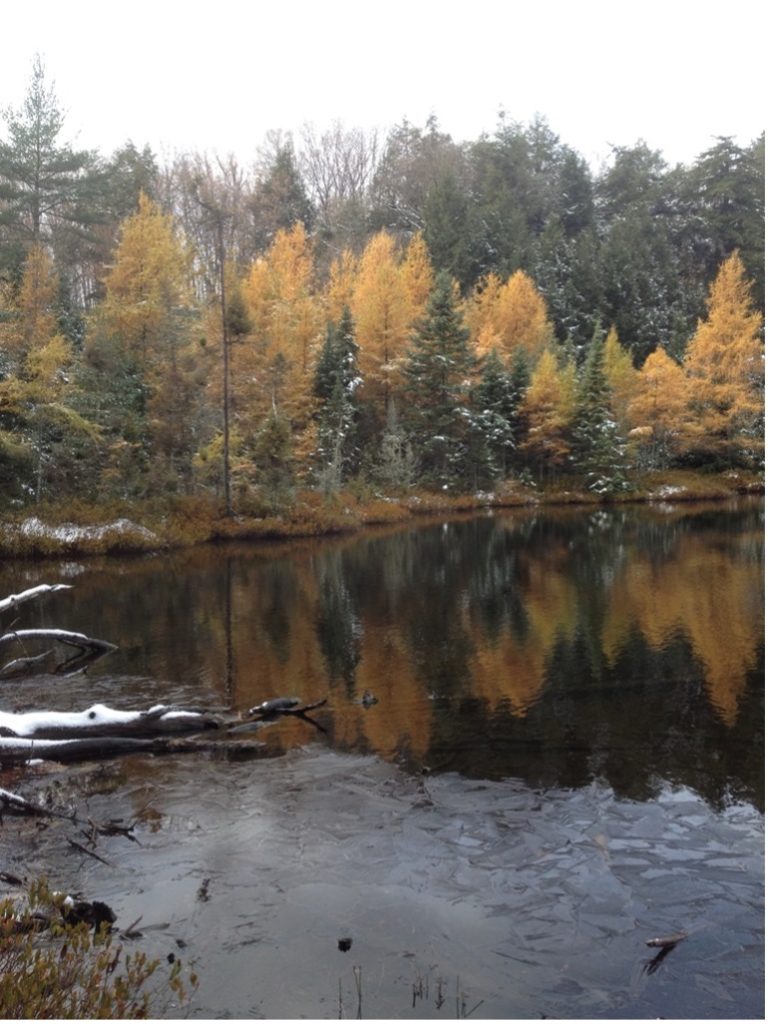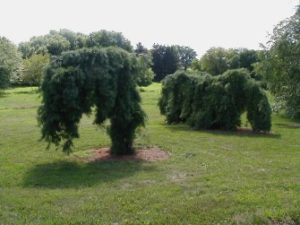By: Matthew Olson
December, 1st 2021
The World of Conifers

Figure 1 White Pine ‘Pendula’
As the holiday season draws near life becomes busy, but the garden is different. Plants are dormant, the migratory birds have departed, and the pollinators are hibernating. Now is an ideal time to observe the conifers. Conifers are woody plants that bear cones, and possess needle like leaves. They come in various sizes and shapes, allowing gardeners to use them in unique ways. Minnesota is home to ten species of native conifers. In today’s blog we’ll be exploring our native conifers, along with a few unusual ones.
White Pine (Pinus strobus) may be the most recognized conifer in Minnesota, for good reason. It can live for hundreds of years and grow over 100’ tall, making it the largest conifer in the Midwest. The feathery needles grow in bundles of five, which is unique among our native pines. This species grows well in open spaces, away from roads where salt is used during winter. For small yards and gardens, a dwarf cultivar of this species can be used. The cultivar ‘Nana’ features a neat and compact habit, allowing it to be grown in garden beds. If you’re looking for adventure, the cultivar ‘Pendula’ is a great choice. This cultivar grows farther horizontally than vertically, often trailing along the ground in several directions.
Balsam Fir (Abies balsemea) is commonly grown as a Christmas tree, but it’s also an excellent tree for Minnesota landscapes. A medium sized tree that grows 50-70’ tall, it can be recognized by its flat glossy needles. Similar in appearance to Spruce, they can be distinguished by observing the end of the needle, which is flat. It’s one of the few shade tolerant conifers that grow well in our climate. Balsam Fir may struggle in urban areas but performs well in locations outside of large cities. The canopy of this species stays full to the ground, allowing it to be used as a screen. This tree is native to central and northern Minnesota, preferring cool summers and cold winters. However, it can be grown throughout Minnesota. For small spaces, the cultivar ‘Nana’ grows only 2’ tall and stays compact.
Eastern Hemlock (Tsuga canadensis) is native to Minnesota, but is uncommon, only being found in the northeast part of the state. It grows up to 80’ tall, and can be recognized by its short, soft, 2 sided needles. This tree performs well in Minnesota landscapes, and can tolerate shade, though it requires some sun to stay compact and full. Though rare in Minnesota forests, Hemlock can be found at many local nurseries. Over 300 cultivars of this tree are available. The Cultivar ‘Summer Snow’ grows only 20’ ft tall and features new white foliage that darkens with age. ‘Moon Frost’ stays compact and round, reaching only 4’ tall and wide, with new white growth.
Blue Spruce (Picea pungens) is widely planted throughout the Midwest. However, it’s susceptible to a variety of fungal diseases, often killing the trees. If you already have Blue Spruce in your yard, don’t cut it down. Know that you should keep an eye on it though. The most common symptom of fungal disease in Blue Spruce are dying needles inside the tree, which spread to the outside of the tree over time. If you see large areas of the tree dying, you should talk to your local extension office about treatment. Many gardeners love the blue needles that grace the new growth of these trees. White Fir (Abies concolor) is an outstanding alternative to Blue Spruce. With similar colored foliage, it creates the same beautiful effect, with lower disease risk. Conifers are often evergreen, retaining their green leaves year-round. However, some are deciduous shedding their leaves in Fall. These trees are known as deciduous conifers. The Tamarack (Larix laricina) is Minnesota’s only native deciduous conifer. A favorite of mine, it grows 40-80 ft, with a conical shape, similar to spruce and fir. It features soft needles that emerge light green in spring and darken during summer. Not only do they shed needles in Fall, but they create a stunning show in the process. Often the last tree to change color, the needles turn bright gold, lighting the bogs of northern Minnesota. In the wild, they are found growing in bogs, but they perform well in residential settings as well. They are exceptional choices for areas with wet soil, but also thrive in soil with average moisture. Several dwarf cultivars exist for this tree as well. ‘Deborah Waxman’ grows to a height of 4’, while other cultivars, such as ‘Pendula’ create a weeping effect, like other weeping conifers.

Figure 2 A stand of Tamarack in late Fall
The Tamarack may be the only tree of this type native to Minnesota, but it’s not the only deciduous conifer that’ll grow here. Bald Cypress (Taxodium distichum) are gaining popularity in the Midwest. This tree is native to the southern U.S and is found in swamps. You won’t find them in the wild here, but they are common in the south. Despite not being found here, they appear to be hardy here, with several mature trees growing in the Twin cities. In Wisconsin, I’ve seen stands of this species that are over 40’ tall, and landscapers are planting it more frequently. It’s uncertain if this species is consistently hardy in the Twin Cities, but it may be worth a try if you have a sheltered location. The needles turn a beautiful shade of orange and red during Fall. A unique feature of this tree is the knees that pop out of the ground around the base as the tree matures.
White Cedar (Thuja occidentalis) are often found growing in northern Minnesota. They grow slowly but can live for hundreds of years. In the wild, they have an open habit, and grow 40’ tall. This tree is often called Arborvitae. Over 100 cultivars exist for this species, many of which are narrow and compact. These cultivars range from 3-40’ tall, making this species popular for screens in the landscape. Most cultivars are dark green, but some offer unique colors, like ‘Fire Chief’ which has bright red growth.
The world of Conifers is vast, with thousands of species and cultivars available for you to enjoy. If you want to learn more about them, I recommend visiting a local arboretum or nursery to check them out. The possibilities are endless. Happy Gardening!
Photo sources- courses.missouristate.edu-Weeping White Pine

